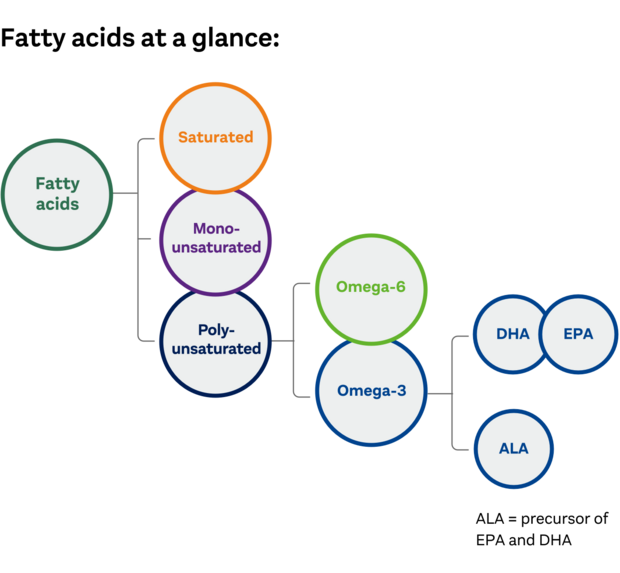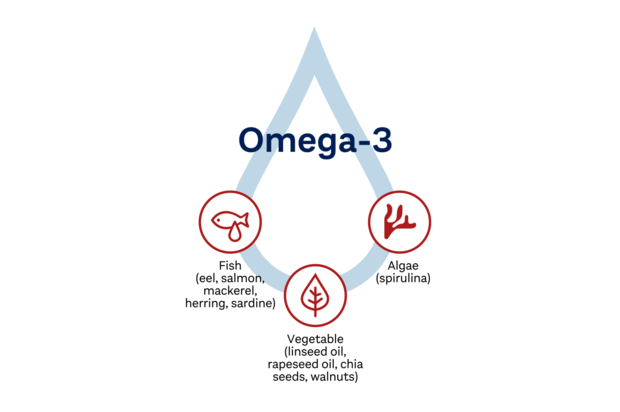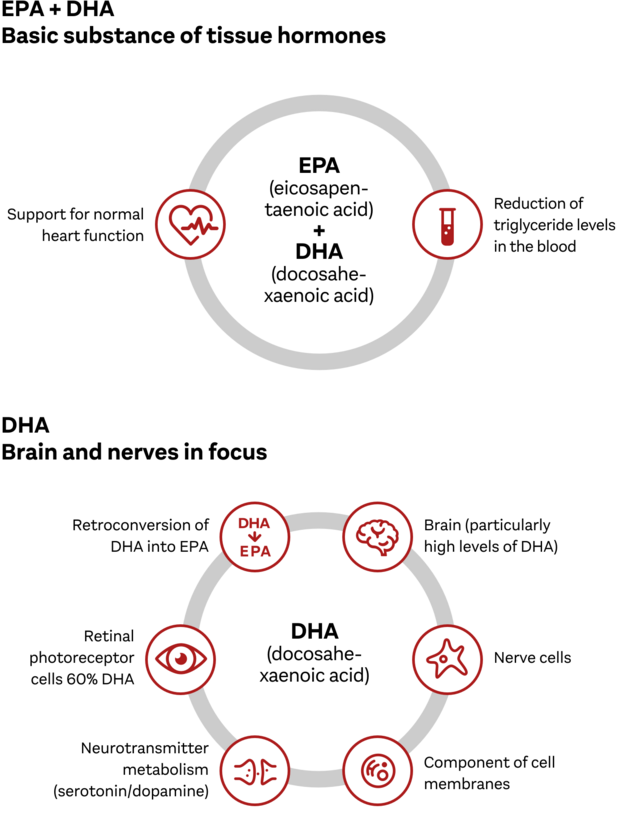What are omega-3 fatty acids, actually?
The omega-3 fatty acids – as well as the omega-6 fatty acids – are essential polyunsaturated fatty acids that we have to obtain from our food. They are the “good” fats. Omega-3 fatty acids can be further differentiated; the most active forms are crucial for their positive health effect:
- EPA (eicosapentaenoic acid)
- DHA (docosahexaenoic acid)
ALA (alpha-linolenic acid) is also an omega-3 fatty acid, but it still needs to be converted into EPA and DHA by the body in order to develop its full health potential.

Which foods contain which fats?
-
Saturated fatty acids:
Contained in animal foods such as sausage, butter as well as palm and coconut oil, for example -
Monounsaturated fatty acids:
Contained in olive oil, rapeseed oil, for example -
Polyunsaturated fatty acids:
The polyunsaturated fatty acids are divided into omega-3 fatty acids (EPA / DHA / ALA) and omega-6 fatty acids. -
Omega-3 fatty acids:
-
EPA (eicosapentaenoic acid):
Contained in cold water fish, krill oil and special microalgae, for example -
DHA (docosahexaenoic acid):
Contained in cold-water fish, krill oil and special microalgae, for example -
ALA (alpha-linolenic acid):
Contained in linseed oil, walnut oil and rapeseed oil, for example
-
-
Omega-6 fatty acids:
(E.g. linoleic and arachidonic acid): Linoleic acid is contained, for example, in sunflower, soyabean and safflower oil. Arachidonic acid is found in animal fats.
Which foods contain omega-3 fatty acids?
We can consume omega-3 fatty acids through various foods. Expert organisations recommend a daily intake of more than 250 mg EPA and DHA.
Animal-based foods:
Vegetarian/vegan foods:
Undisputedly, it makes the most sense to consume all the important nutrients through a balanced and varied diet. However, if it is not possible to achieve or maintain healthy omega-3 levels through diet, high-quality supplements are safe alternatives!

ALA (alpha-linolenic acid) – plant-based omega-3
ALA (alpha-linolenic acid) is the plant precursor of the polyunsaturated omega-3 fatty acids DHA and EPA. It is found in vegetable oils such as linseed oil or rapeseed oil, but also in green leafy vegetables, linseed and walnuts. However, the omega-3 from vegetable oils still needs to be converted into biologically valuable EPA and DHA in the body.
The yield is meagre: the conversion rate is only 2–5% and depends on various factors.
It is therefore difficult to meet the need for omega-3 fatty acids with vegetable oils alone – but they are a useful supplement.
Ratio of omega-3 and omega-6 fatty acids
Both omega-3 and omega-6 fatty acids are essential polyunsaturated fatty acids. The proportion we consume these through our food is crucial for our health.
Omega-3 and omega-6 fatty acids are often mentioned in inflammatory diseases because they regulate inflammatory processes. The pro-inflammatory arachidonic acid is an omega-6 fatty acid that should only be consumed in moderation. It is particularly found in dairy products, sausages and ready meals, but also in processed vegetable oils such as margarine. A sufficient supply of omega-3 with EPA and DHA is an anti-inflammatory counterpoint to the omega-6 fatty acids.
A ratio of 5:1 (omega-6 to omega-3) is recommended. We should therefore only ensure five times as much omega-6 as omega-3 fatty acids in our food.
In fact, in the Western world there is unfortunately a strong shift in the ratio of 15:1. But this imbalance of omega-3 and omega-6 fatty acids can have a decisive influence on our health.
EPA and DHA – an overview
Eicosapentaenoic acid (EPA) and docosahexaenoic acid (DHA) are the most biologically active omega-3 fatty acids. EPA is the basic substance of tissue hormones and serves our body as a starting substance for the formation of the hormone-like substances known as eicosanoids. They are significantly involved in numerous processes in human metabolism such as blood circulation and vascular protection.
DHA is considered an essential membrane component. All our body cells are covered with membranes that ensure that cells are alive and healthy. The focus is particularly on the brain, eyes, and nerves. DHA makes up around 97% of the omega-3 fatty acids in the brain and 93% in the retina!
EPA and DHA are true all-rounders for health:

How do the omega-3 fatty acids EPA and DHA work?
Omega-3 fatty acids are proven to have many positive effects on our health. The European Food Safety Authority (EFSA) also confirms the following nutritional effects of EPA and DHA with sufficient and regular intake:
Effect on the brain
The highest levels of DHA are found in the areas of the brain such as the cerebral cortex, mitochondria, and synapses. 25% of the fat in the brain is DHA!
-
DHA is involved in the formation of links and transmission of signals in the brain.
DHA helps maintain normal brain function.
The positive effect is achieved at a daily intake of 250 mg DHA.
Effect on the heart
The valuable omega-3 fatty acids DHA (docosahexaenoic acid) and EPA (eicosapentaenoic acid) can make an important contribution to heart health and normal heart function.
-
EPA and DHA help to maintain normal heart function.
The positive effect is achieved at a daily intake of 250 mg EPA/DHA.
Effect on the eyes
The polyunsaturated fatty acids are important components of the photoreceptor cells and the retina. At 60%, DHA is the most abundant fatty acid in the photoreceptor cells. It also plays a role in the structure of the retina.
-
DHA helps to maintain normal vision.
The positive effect is achieved at a daily intake of 250 mg DHA.
Pregnancy and newborns:
Especially in the last trimester of pregnancy and in the first months of life, omega-3 fatty acids have a positive influence on child development. In the womb, the development of the brain is more rapid than in any other phase of life. And DHA is already being incorporated as a building block for the child’s brain, nerve tissue and eyes.
-
DHA from the mother contributes to normal development of the eyes and brain in the unborn child.
Pregnant or breastfeeding women are recommended to consume 200 milligrams of DHA per day in addition to the recommended DHA and EPA intake of 250 milligrams.
DHA supports normal development of the eyes and brain of unborn and breastfed infants.
Omega-3 index – How can we test omega-3 levels?
If you want to know how good your own supply of omega-3 fatty acids is, you can seek advice from your doctor or buy a home self-test from the pharmacy. Using a standardized measurement method, the “HS Omega-3 Index”, the omega-3 level is determined. You must pay for this blood test yourself. Desirable results are an omega-3 index between 8 and 11%.
A recent study shows*2: It takes 2000 mg of EPA/DHA daily to double a low omega-3 index from 4% to 8% (duration: 3 months)!
Daily requirement of omega-3 fatty acids
In order to consume enough valuable omega-3 fatty acids, the recommended consumption according to the DGE (German Nutrition Society) is:
both children and adults should eat 200–220 g of fish per week. The following is optimal: 80–150 g lean fish plus 70 g oily fish.
It does not matter whether the fish is freshly prepared, canned or frozen. The WHO (World Health Organization) requires a daily intake of more than 200 mg EPA and DHA as a basic supply to maintain the normal functions of the body.
Basic supply of omega-3 fatty acids according to the recommendations of the expert associations:
- Children up to 2 years: 100 mg/day
- Children from 2 years up to pre-puberty: 100–200 mg/day
- Adults: 200 mg/day
Increased need for omega-3 fatty acids
In some life situations, there may be an increased need for omega-3s:
Pregnant and breastfeeding women:
Since pregnant women have to supply the unborn baby with the vital omega-3 fatty acids via the umbilical cord, the daily requirement of the expectant mother increases. A sufficient supply of EPA and DHA benefits mother and child and supports the normal development of the eyes and brain in the foetus and the breastfed baby.
-
Daily requirement: 250 mg EPA + DHA + 200 mg DHA
Athlete*3:
Recent studies** show that competitive athletes often have a poor supply of omega-3 fatty acids. Athletes in particular need healthy fats, as they can have a positive effect on the heart, muscles and joints.
-
Daily requirement: 1000–2000 mg EPA + DHA
EPA and DHA improve the resilience of muscles and joints during sports and recovery in the subsequent regeneration phase!
Older people – mental health:
The fact is: per year of life, brain mass decreases by about 1% in old age. Omega-3 supplementation preserves grey matter and improves brain function*4.
-
Daily requirement: 2200 mg omega-3 fatty acids (of which 1320 mg EPA + 880 mg DHA)
Cardiovascular protection:
The adequate intake of EPA and DHA is advocated by many experts in studies on the protection of the heart. People at increased risk of cardiovascular disease in particular benefit from regular fish consumption.
- Daily requirement: 250 mg EPA + DHA
Quality – Nutritional supplements with omega-3 fatty acids
Of course, you can be sure of high quality with Doppelherz products! Our quality standards include PureMax technology, ECO-HarvestingTM technology and the V-Label.
1* Omega-3 supply status
Germany's families eat too little fish and thus consume too little omega-3 fatty acids. All age groups fall significantly short of the recommended amount – by up to four times in children, according to the nutritional report of the German Nutrition Society (DGE); 2012.
www.ak-omega-3.de/aktuelles-thema/bundesbuerger-essen-zu-wenig-fisch
www.ak-omega-3.de/presse/publikumsmedien/zu-wenig-fisch-zu-wenig-omega-3
2* Targeted improvement of the omega-3 index
Current study shows: High doses of 2000 mg EPA/DHA replenish empty omega-3 stores. Result: It takes 2000 mg of EPA/DHA daily to double a low omega-3 index from 4% to 8% (duration: 3 months).
Walker et al. (2019): Predicting the effects of supplemental EPA and DHA on the omega-3 index. Am J Clin Nutr. 2019 Oct 1;110(4):1034-1040.
3* Omega-3 for athletes
by Schacky C, Kemper M, Haslbauer R, Hall M.: Low Omega-3 Index in 106 German elite winter endurance athletes: a pilot study.
Int J Sport Nutr Exerc Metab. 2014 Oct;24(5):559-64.
1 Simopoulos, A. P.: Omega-3 Fatty Acids and Athletics. Current Sports Medicine Reports, 2007, 6:230-236.
ak-omega-3.de/2012/11/omega-3-fettsaeuren-sind-wichtig-in-der-sporternaehrung-2/
4* Omega-3 protects the brain
Witte AV et al.: Long-Chain Omega-3 Fatty Acids Improve Brain Function and Structure in Older Adults. Vereb Cortex. 2013 Jun 24.
Omega-3 for the heart and circulatory system
Statin patients can usefully supplement their cholesterol-lowering therapy with omega-3 fatty acids.
Nambi V. et al.: Combination therapy with statins and omega-3 Fatty acids. Am J Cardiol. 2006 Aug.
Maki KC et al. (2012): Treatment options for the management of hypertriglyceridemia. J Clin Lipidol.
